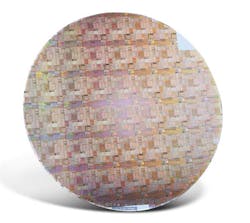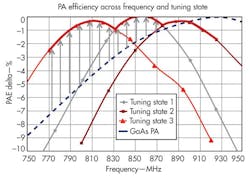This file type includes high resolution graphics and schematics when applicable.
Wireless communications technologies have grown in complexity as they are applied to an increasing number of requirements to transfer voice, audio, video, and data from transmitters to receivers using available frequencies and bandwidths. The electronic design requirements of modern wireless systems can be quite challenging, with so many different frequencies and modulation formats in use. An almost endless string of RF front ends is needed to meet the different radio requirements.
Alternately, radio designers can reach for a single semiconductor solution: a reconfigurable RF front end (RFFE) integrated circuit (IC) from fabless semiconductor company Peregrine Semiconductor Corp. Named UltraCMOS Global 1, the RFFE essentially combines many of the performance levels possible with gallium arsenide (GaAs) semiconductor materials and the design flexibility of silicon CMOS. The UltraCMOS Global 1 RFFE chip includes a high-performance power amplifier (PA), post-PA switch, an antenna switch, and antenna tuner, with support for envelope tracking and Mobile Industry Processor Interface (MIPI) compatibility.
This RFFE chip should greatly simplify support for such wide ranging wireless communications standards as fourth-generation (4G) cellular Long Term Evolution (LTE). Fabricated on the silicon-on-insulator (SOI) process, the device provides the flexibility to meet the needs of a wide range of frequency bands and operating modes, with the performance of gallium arsenide (GaAs) semiconductor technology. Global 1 utilizes the latest generation of the UltraCMOS technology, the UltraCMOS 10 technology platform (Fig. 1).
The UltraCMOS 10 platform is a proprietary SOI technology, manufactured at GLOBALFOUNDRIES. The process is capable of fabricating devices and circuit elements with 130-nm features, taking advantage of the high isolation between devices and high output levels from active devices in densely packed circuitry. In terms of the process figure of merit (FOM) RONCOFF, based on the “on” resistance and “off” capacitance of devices such as switches fabricated with the process, this 130-nm process yields considerably lower RONCOFF than available 130- and 180-nm SOI processes, and even lower value than with GaAs processes.
As an example of current wireless product design, the iPad Air portable wireless pad computer from Apple works across 14 different radio bands and almost 100 networks worldwide. Competitive products require either a similarly powerful front-end design or a host of different front-end IC solutions packed into a similarly small enclosure. The trend in front-end design is clearly pointing to an increased need for flexibility and versatility.
The high level of integration possible with UltraCMOS technology enables such flexibility and versatility. UltraCMOS 10 technology enables integration of high-performance RF/microwave, mixed-signal, passive elements, and digital functions on a single CMOS IC. The UltraCMOS technology family has been well received over the years in the form of the firm’s switch products (over 2 billion of the company’s switches have been shipped to customers over the lifetime of the company), which include absorptive and reflective designs and 50- and 75-Ω switches for communications and television-broadcast markets.
Flexible Front End
The Global 1 reconfigurable RFFE system delivers the scalability to support the large number of frequency bands and modes of operation needed to support the many variants of 4G LTE. The firm demonstrated the Global 1 PA at the recent Mobile World Congress conference and exhibition. The three-path, multimode, multiband PA works with high-speed switching to route signals to different antennas and antenna tuners within the UltraCMOS Global 1 reconfigurable RFFE.
The PA offers performance comparable to GaAs PAs for these LTE frequency bands, with improved efficiency compared to conventional silicon CMOS amplifier designs. It covers a broad bandwidth, 700 to 2700 MHz, for coverage of a large number of different LTE frequency bands. When tuned for different portions of that operating bandwidth, the Global 1 RFFE PA achieves performance exceeding traditional GaAs amplifiers for this frequency range, with high efficiency in the different tuned frequency ranges (Fig. 2).
As the performance of this PA demonstrates, UltraCMOS Global 1 is capable of high efficiency and excellent linearity. The PA’s PAE performance approaches 50% when tested with a wideband-code-division-multiple-access (WCDMA) waveform at an adjacent-channel leakage ratio (ACLR) of -38 dBc. The PA achieves this outstanding PAE performance without the use of envelope tracking, although the PA natively supports all envelope-tracking approaches currently on the market for even better efficiency when needed. Enhancements in efficiency with envelope tracking are band specific, so the improvement in PAE with envelope tracking will depend upon operating frequencies.
The UltraCMOS Global 1 reconfigurable RFFE simplifies support of growing LTE markets by allowing platform providers to use a single reference platform for a wide variety of final wireless products. The simplicity also results in reduced reference design development costs and validation time. In addition, R&D time and expenses are reduced, the time to market for the final product is accelerated, and wireless product manufacturers benefit from streamlined supply chains and simplified inventory management with the single reference platform.
For network managers, the efficient reconfigurable RFFE should provide improved coverage. For consumers, this first platform should mean better reception and performance with longer battery lifetimes. The UltraCMOS Global 1 system is expected to complete platform integration in 2014 and be in volume production by late 2015.
Peregrine Semiconductor Corp., 9380 Carroll Park Dr., San Diego, CA 92121; (858) 731-9400, FAX: (858) 731-9499.
This file type includes high resolution graphics and schematics when applicable.



